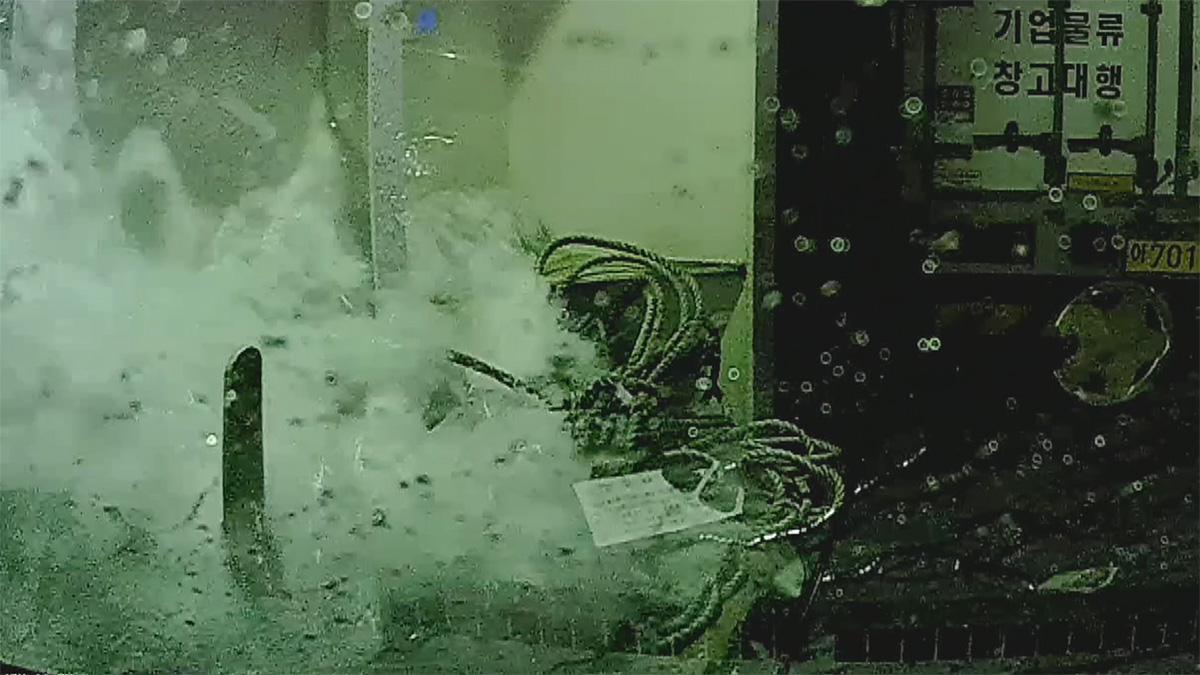
Broken Windows in Cargo Deck a Key Factor of Rapid Influx of Water
2017년 09월 15일 10시 20분
The Korea Center for Investigative Journalism (KCIJ)-Newstapa exclusively obtained black box videos derived from vehicles loaded inside the cargo decks, and analyzed them.
Vast possibilities in the cause of the capsizing have now narrowed down to the ferry’s own problems -- not an external shock or an internal explosion as some have argued so far.
It means that the Sewol ferry, back on the day of disaster, had a bad stability so that the ferry’s body was wobbly in a normal situation without a sharp turn.
Based on the clues indicated in the black box videos, we spelled out what factors must be touched on in future investigations and which direction the investigations must head towards.
Listed much sharply than expected ... allows that the AIS
Recovered black box videos helped proving two things about causes of the Sewol ferry’s capsizing: Possibility of external shock is very low, and the ferry’s list and cargos’ sliding had happened more rapidly than expected.
Such facts correspond with the Auto Identification System (AIS) tracking data. The sound of cargos colliding is first heard in the clip at 8:49:26 a.m.
The AIS data right after this moment shows that the turning angle of the ferry’s bow -- which initially was veering to the starboard side -- changes more sharply to get the ferry turn by 1 degree every second.
The AIS tracking data from 8:49:36 a.m. to 8:49:50 a.m., during which the ferry rapidly listed from 21 degrees to 47 degrees, indicates a drastic change in turns.
The ferry’s bow changes its direction drastically from 178 degrees to 234 degrees within just 14 seconds, which is equivalent with a turn of 2.3 degrees per second.
The abrupt changes in the bow’s direction were barely explained in the previous researches and experiments on the capsizing of the Sewol ferry.
It was because the ferry’s stability calculated at these studies turned out not as bad to tilt the ferry this much, even after inputting all types of indices on things loaded in the ferry, ranging from cargos, ballast water to fresh water and fuel.
However, factors and scenes found in the newly-recovered black box videos have proved that the sharp tilt was actually possible as seen in the ferry’s AIS data.
“Based on what’s seen on the video, I was able to assume that the ferry listed very abruptly from 20 degrees to 30 degrees, and some of the cargos moved during the short period of time. Such move seems to match the abrupt fluctuations of AIS tracking data,” Im Nam-kyun, a professor of Navigation Science at Mokpo National Maritime University, said after watching the video. “This means, the Sewol ferry’s stability could have been much worse than it was officially reported.”
Sewol ferry’s stability assumed to be much worse than widely known … What type of data was inaccurate?
As the existing stability data is assumed to be worse than expected, KCIJ-Newstapa had to proceed the analyses in an opposite way.
As it was proved that the ferry listed rapidly in an early stage of sinking, there was no way other than accepting the fact that the ferry’s stability was in such a bad shape.
This means, different types of weight data used in calculating the Sewol ferry’s stability at the moment of sinking -- including cargos, ballast water, fresh water and fuel -- were inaccurate.
Thus, the ferry’s investigations must focus on figuring out the accurate data.
In fact, cargos that were previously unreported have been collected from the salvaged Sewol ferry. Two units of fork crane, a motor bicycle and a container box, which were not even identified from investigations carried out by the Special Sewol Investigative Commission.
This proves that the cargo weight data, which was utilized in calculating the stability, was inaccurate.
Likewise, Newstapa reached a conclusion that the existing weight data like ballast water, fresh water and fuel, which greatly influences to the stability index, is not accurate as well.
To date, all investigations and calculations in figuring out the stability directly utilized numbers that Kang Won-sik, the first-class sailor, and Park Ki-ho, the chief engineer, provided at official probes.
However, now, another round of probes is required on the two people as their data was proved to be inaccurate.
The black box, which was recovered after 3 years and 6 months, is now offering an opportunity to investigate the cause of the tragic sinking of the ferry.
This also means that the investigations can be even more detailed as more black box videos are collected and recovered.
뉴스타파는 권력과 자본의 간섭을 받지 않고 진실만을 보도하기 위해, 광고나 협찬 없이 오직 후원회원들의 회비로만 제작됩니다. 월 1만원 후원으로 더 나은 세상을 만들어주세요.